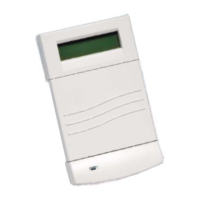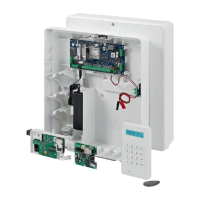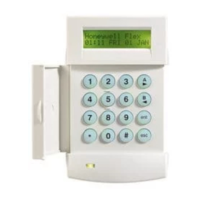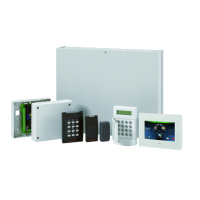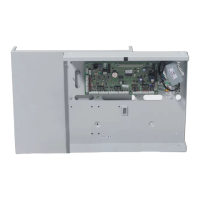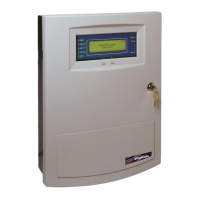50 GWF-7075 Addressable Fire Alarm Control Panel Manual — P/N LS10147-002GF-E:E 06/11/2019
Programming Modules
Alarm Delay Characteristics
The programmed Zone Type is provided for user reference only. To modify the Zone Type, use the HFSS Honeywell Fire Software Suite
Software Suite. Table 7.2 list the Alarm Delay choices and a description of each. Then press <Enter>.
Heat Detector Sensitivity
Use this feature to set the temperature to which high temperature detectors respond. All detectors in the zone will respond in the same
way. The range for ATD-HL2F heat detector is from 135°F to 190°F.
The ATD-HL2F heat detectors are absolute temperature devices. This means that they respond to an alarm immediately if the tempera-
ture in the zone goes above the programmed temperature.
1. Enter the temperature at which the heat detector will respond, or use the <Up> or <Down> arrow keys to scroll through the range.
Then press <Enter>.
Smoke Detector Sensitivity
All detectors in the zone will respond as programmed in this menu location.
* Automatic drift compensation is always in effect for all detectors. See Section 8.4.11 for information about how to
check if a detector is in compliance.
1. Use the <Up> or <Down> arrows to scroll through the options, then press <Enter>.
NOTE: In System Options, if you set <OFF> for Daytime/Nighttime Sensitivity, you can only see smoke sensitivity on the GWF-7075
panel. (See Section 7.4.3). Otherwise, if you set <ON> for Daytime/Nighttime Sensitivity, this will bring up a Smoke Sensitivity Day and
Night, two separate widgets with sensitivity selection being set as either low, med, or high for each device.
Type of Alarm
Delays
Description
1-Count
One Count (No Delay).
When you enable this option, an alarm occurs immediately when a single device of any of the following types goes
into alarm: detector, manual pull, water flow, Aux1 or Aux2.
Use this option for the most typical operations and is the default for all zones.
2-Count
When you use this type of alarm delay, two or more detectors within the zone must go into alarm in order for the zone
to report an alarm.
Switches of type manual pull, Detector switches, water flow, Aux1 and Aux2 are an exception; they will cause an
alarm when only one switch is in alarm.
When a single detector is in alarm in a 2-Count zone, the system enters a pre-alarm condition. In a pre-Alarm
condition, the touchpad PZT beeps and the annunciator display indicates that a pre-alarm has occurred.
If the zone has been mapped to an output group for the pre-alarm event, the output group will activate.
The pre-alarm will not be reported to the central station.
When two count is used, detector spacing shall be cut in half. You should not use the alarm verification feature, and
no delay shall be used.
Alarm Verification
Alarm verification is an optional false alarm prevention feature that verifies an alarm condition by resetting the smoke
detector. If the alarm condition still exists by the time the reset cycle is completed, the detector will go into alarm.
If the detector is no longer in alarm, no report will go to the central station. The alarm verification sequence is ignored
if the zone is already in alarm.
PAS-Positive Alarm
Sequence
Use this option with an acknowledge switch. An alarm is delayed for 15 seconds, broadcasting on-site personnel a
chance to investigate the alarm. If the acknowledge switch is not activated within 15 seconds, an alarm automatically
occurs.
If this option is enabled for a zone, the zone will respond to an alarm condition as follows:
• The zone will not go into alarm for 15 seconds to allow an on-site operator to activate the acknowledge switch.
• If the operator does not press the acknowledge switch within 15 seconds, the zone will go into alarm.
• If the operator presses the acknowledge switch within 15 seconds, a 180-second time-frame will begin counting
down. This time-frame allows the operator to investigate the cause of the alarm.
• If the operator performs a reset within 180 seconds, the alarm will not occur.
• If the operator does not perform a reset within 180 seconds, an alarm will occur automatically.
• The P.A.S. feature will be overridden if another alarm occurs.
SNGL ILOCK See Section 8.7.1 for single interlock releasing operation.
DBL ILOCK See Section 8.7.2 for double interlock releasing operation.
Note: MCS-COF and other CO detectors can only be installed in a 1 count zone.
Table 7.2 : Alarm Delay Types
WARNING: DRIFT COMPENSATION IS AUTOMATIC FOR ALL SMOKE DETECTORS (PHOTOELECTRIC). THE
FEATURE IS ALWAYS IN EFFECT, NO PROGRAMMING IS REQUIRED. SEE SECTION 8.4.11 FOR INFORMATION
ABOUT HOW TO CHECK IF A DETECTOR IS IN UL COMPLIANCE.
Detector
Protocol
Type of Smoke
Detector
Choices Comments
Velociti
ASD-PL2F,
MCS-ACCLIMATE2F, &
ASD-PTL2F
Low (3.5% obscurity) If the day/night sensitivity option is selected, you can have different
sensitivity settings during the day and at night. You can determine the
days of the week that Day/Night Sensitivity will automatically adjust.
You can also designate specific days as Holidays. Holiday and
weekend days use night sensitivity for the entire day
Medium (2.5% obscurity)
High (1.5% obscurity)
DNR with
ASD-PL2FR or
ASD-PL2F
Low (2.5% obscurity)
Medium (2.0% obscurity)
High (1.5% obscurity)
Table 7.3 : Velociti Detector Sensitivity Choices*
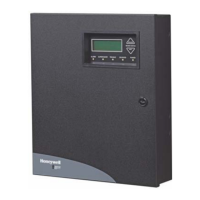
